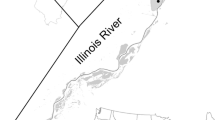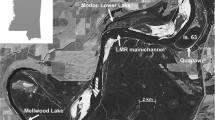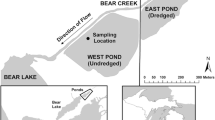Abstract
Intermittent surface connectivity can influence aquatic systems, since chemical and biotic movements are often associated with water flow. Although often referred to as fill and spill, wetlands also fill and merge. We examined the effects of these connection types on water levels, ion concentrations, and biotic communities of eight prairie pothole wetlands between 1979 and 2015. Fill and spill caused pulsed surface water connections that were limited to periods following spring snow melt. In contrast, two wetlands connected through fill and merge experienced a nearly continuous, 20-year surface water connection and had completely coincident water levels. Fill and spill led to minimal convergence in dissolved ions and macroinvertebrate composition, while these constituents converged under fill and merge. The primary factor determining differences in response was duration of the surface water connection between wetland pairs. Our findings suggest that investigations into the effects of intermittent surface water connections should not consider these connections generically, but need to address the specific types of connections. In particular, fill and spill promotes external water exports while fill and merge favors internal storage. The behaviors of such intermittent connections will likely be accentuated under a future with more frequent and severe climate extremes.









Similar content being viewed by others
References
Ali GW, Roy AG (2009) Revisiting hydrologic sampling strategies for an accurate assessment of hydrologic connectivity in humid temperate systems. Geography Compass 3:350–374
Anteau MJ (2012) Do interactions of land use and climate affect productivity of waterbirds and prairie-pothole wetlands? Wetlands 32:1–9. doi:10.1007/s13157-011-0206-3
Barton AB, Herczeg AL, Dahlhaus PG, Cox JW (2013) A geochemical approach to determining the hydrological regime of wetlands in a volcanic plain, south–eastern Australia. In: Ribeiro L, Stigter TY, Chambel A, de Melo Condesso MT, Monteiro JP, Medeiros A (eds) Groundwater and Ecosystems. CRC Press, Boca Raton,
Biswas A, Chau HW, Bedard-Haughn AK, Si BC (2012) Factors controlling soil water storage in the hummocky landscape of the prairie pothole region of North America. Canadian Journal of Soil Science 92:649–663. doi:10.4141/cjss2011-045
Blann KL, Anderson JL, Sands GR, Vondracek B (2009) Effects of agricultural drainage on aquatic ecosystems: a review. Critical Reviews in Environmental Science and Technology 39:909–1001. doi:10.1080/10643380801977966
Brannen R, Spence C, Ireson A (2015) Influence of shallow groundwater–surface water interactions on the hydrological connectivity and water budget of a wetland complex. Hydrological Processes 29:3862–3877. doi:10.1002/hyp.10563
Brunet NN, Westbrook CJ (2012) Wetland drainage in the Canadian prairies: Nutrient, salt and bacteria characteristics. Agriculture, Ecosystems & Environment 146:1–12
Chu X (2015) Delineation of pothole-dominated wetlands and modeling of their threshold behaviors. Journal of Hydrologic Engineering. doi:10.1061/(ASCE)HE.1943-5584.0001224
Cohen MJ, Creed IF, Alexander L, Basu NB, Calhoun AJK, Craft C, D’Amico E, DeKeyser E, Fowler L, Golden HE, Jawitz JW, Kalla P, Kirkman LK, Lane CR, Lang M, Leibowitz SG, Lewis DB, Marton J, McLaughlin DL, Mushet DM, Raanan-Kiperwas H, Rains MC, Smith L, Walls SC (2016) Do geographically isolated wetlands influence landscape functions? Proceedings of the National Academy of Sciences 113:1978–1986. doi:10.1073/pnas.1512650113
Connon RF, Quinton WL, Craig JR, Hayashi M (2014) Changing hydrologic connectivity due to permafrost thaw in the lower Liard River valley, NWT, Canada. Hydrological Processes 28:4163–4178. doi:10.1002/hyp.10206
Cook BJ, Hauer FR (2007) Effects of hydrologic connectivity on water chemistry, soils, and vegetation structure and function in an intermontane depressional wetland landscape. Wetlands 27:719–738. doi:10.1672/0277-5212(2007)27[719:eohcow]2.0.co;2
Dou P, Cui B, Xie T, Dong D, Gu B (2016) Macrobenthos diversity response to hydrological connectivity gradient. Wetlands 36(Suppl 1):S45–S55. doi:10.1007/s13157-014-0580-8
Eisenlohr, WS Jr. (1972) Hydrologic investigations of prairie potholes in North Dakota, 1959–68. U.S. Geological Survey, Washington, DC
Fahrig L, Merriam G (1985) Habitat patch connectivity and population survival. Ecology 66:1762–1768. doi:10.2307/2937372
Freeland JA, Richardson JL, Foss LA (1999) Soil indicators of agricultural impacts on northern prairie wetlands: Cottonwood Lake research area, North Dakota, USA. Wetlands 19:56–64. doi:10.1007/bf03161733
Gleason RA, Tangen BA, Laubhan MK, Kermes KE, Euliss NH Jr. (2007) Estimating water storage capacity of existing and potentially restorable wetland depressions in a subbasin of the Red River of the North. p. 25 + app. U.S. Geological Survey, Jamestown, ND
Goldhaber MB, Mills CT, Morrison JM, Stricker CA, Mushet DM, LaBaugh JW (2014) Hydrogeochemistry of prairie pothole region wetlands: role of long-term critical zone processes. Chemical Geology 387:170–183
Hanson MA, Zimmer KD, Butler MG, Tangen BA, Herwig BR, Euliss NH (2005) Biotic interactions as determinants of ecosystem structure in prairie wetlands: an example using fish. Wetlands 25:764–775. doi:10.1672/0277-5212(2005)025[0764:biadoe]2.0.co;2
Hitt NP, Angermeier PL (2008) River-stream connectivity affects fish bioassessment performance. Environmental Management 42:132–150. doi:10.1007/s00267-008-9115-5
Hopp L, McDonnell JJ (2009) Connectivity at the hillslope scale: identifying interactions between storm size, bedrock permeability, slope angle and soil depth. Journal of Hydrology 376:378–391. doi:10.1016/j.jhydrol.2009.07.047
Huang S, Young C, Feng M, Heidemann K, Cushing M, Mushet DM, Liu S (2011) Demonstration of a conceptual model for using LiDAR to improve the estimation of floodwater mitigation potential of prairie pothole region wetlands. Journal of Hydrology 405:417–426
Huang S, Young C, Abdul-Aziz OI, Dahal D, Feng M, Liu S (2013) Simulating the water budget of a prairie potholes complex from LiDAR and hydrological models in North Dakota, USA. Hydrological Sciences Journal 58:1434–1444. doi:10.1080/02626667.2013.831419
Janzen D, McDonnell JJ (2015) A stochastic approach to modelling and understanding hillslope runoff connectivity dynamics. Ecological Modelling 298:64–74
Jencso KG, McGlynn BL, Gooseff MN, Bencala KE, Wondzell SM (2010) Hillslope hydrologic connectivity controls riparian groundwater turnover: implications of catchment structure for riparian buffering and stream water sources. Water Resources Research 46. doi:10.1029/2009wr008818
Johnson WC, Boettcher SE, Poiani KA, Guntenspergen G (2004) Influence of weather extremes on the water levels of glaciated prairie wetlands. Wetlands 24:385–398. doi:10.1672/0277-5212(2004)024[0385:ioweot]2.0.co;2
Jordan SJ, Benson WH (2015) Sustainable watersheds: integrating ecosystem services and public health. Environmental Health Insights 9(S2):1–7. doi:10.4137/EHI.S19586
Kang S-R, King SL (2013) Effects of hydrologic connectivity and environmental variables on nekton assemblage in a coastal marsh system. Wetlands 33:321–334
LaBaugh JW, Swanson GA (2003) Spatial and temporal variability in specific conductance and chemical characteristics of wetland water and in water column biota in the wetlands in the Cottonwood Lake area. In: Winter TC (ed) Hydrological, chemical, and biological characteristics of a prairie pothole wetland complex under highly variable climate conditions : the Cottonwood Lake area, east-central North Dakota. US Geological Survey Professional Paper 1675, Denver
LaBaugh JW, Mushet DM, Rosenberry DO, Euliss NH Jr, Goldhaber MB, Mills CT, Nelson RD (2016) Changes in pond water levels and surface extent due to climate variability alter solute sources to closed-basin prairie-pothole wetland ponds, 1979 to 2012. Wetlands. doi:10.1007/s13157-016-0808-x
Leibowitz SG (2003) Isolated wetlands and their functions: an ecological perspective. Wetlands 23:517–531
Leibowitz SG (2015) Geographically isolated wetlands: why we should keep the term. Wetlands 35:997–1003. doi:10.1007/s13157-015-0691-x
Leibowitz SG, Nadeau T-L (2003) Isolated wetlands: state-of-the-science and future directions. Wetlands 23:663–684
Leibowitz SG, Vining KC (2003) Temporal connectivity in a prairie pothole complex. Wetlands 23:13–25. doi:10.1672/0277-5212(2003)023[0013:tciapp]2.0.co;2
Manly BFJ (2007) Randomization, Bootstrap and Monte Carlo Methods in Biology. Chapman and Hall/CRC Press, Boca Raton
Marton JM, Creed IF, Lewis DB, Lane CR, Basu NB, Cohen MJ, Craft CB (2015) Geographically isolated wetlands are important biogeochemical reactors on the landscape. Bioscience 65:408–418. doi:10.1093/biosci/biv009
McCauley LA, Anteau MJ, van der Burg MP, Wiltermuth MT (2015) Land use and wetland drainage affect water levels and dynamics of remaining wetlands. Ecosphere 6:1–22. doi:10.1890/ES14-00494.1
McCune B, Mefford MJ (2011) PC-ORD. Multivariate Analysis of Ecological Data. Version 6. MjM Software, Gleneden Beach, OR
McDonnell JJ (2013) Are all runoff processes the same? Hydrological Processes 27:4103–4111. doi:10.1002/hyp.10076
McLean KI, Mushet DM, Stockwell CA (2016) From “duck factory” to “fish factory”: climate induced changes in vertebrate communities of prairie pothole wetlands and small lakes. Wetlands. doi:10.1007/s13157-016-0766-3
Meyboom P (1967) Mass-transfer studies to determine the groundwater regime of permanent lakes in hummocky moraine of western Canada. Journal of Hydrology 5:117–142. doi:10.1016/S0022-1694(67)80051-9
Mitchell MGE, Bennett EM, Gonzalez A (2013) Linking landscape connectivity and ecosystem service provision: current knowledge and research gaps. Ecosystems 16:894–908. doi:10.1007/s10021-013-9647-2
Mushet DM, Calhoun AJK, Alexander LC, Cohen MJ, DeKeyser ES, Fowler L, Lane CR, Lang MW, Rains MC, Walls SC (2015) Geographically isolated wetlands: rethinking a misnomer. Wetlands 35:423–431. doi:10.1007/s13157-015-0631-9
Nachshon U, Ireson A, van der Kamp G, Davies SR, Wheater HS (2014) Impacts of climate variability on wetland salinization in the North American prairies. Hydrology and Earth System Sciences 18:1251–1263. doi:10.5194/hess-18-1251-2014
Nadeau T-L, Rains MC (2007) Hydrological connectivity between headwater streams and downstream waters: how science can inform policy. Journal of the American Water Resources Association 43:118–133
Niemuth ND, Wangler B, Reynolds RE (2010) Spatial and temporal variation in wet area of wetlands in the prairie pothole region of North Dakota and South Dakota. Wetlands 30:1053–1064. doi:10.1007/s13157-010-0111-1
Peck JE (2010) Multivariate Analysis for Community Ecologists: Step-by-step Using PC-ORD. MjM Software Design, Gleneden Beach, OR
Pringle C (2003) What is hydrologic connectivity and why is it ecologically important? Hydrological Processes 17:2685–2689. doi:10.1002/hyp.5145
Racchetti E, Bartoli M, Soana E, Longhi D, Christian RR, Pinardi M, Viaroli P (2011) Influence of hydrological connectivity of riverine wetlands on nitrogen removal via denitrification. Biogeochemistry 103:335–354. doi:10.1007/s10533-010-9477-7
Rahel FJ (2007) Biogeographic barriers, connectivity and homogenization of freshwater faunas: it's a small world after all. Freshwater Biology 52:696–710. doi:10.1111/j.1365-2427.2006.01708.x
Rains MC, Leibowitz SG, Cohen MJ, Creed IF, Golden HE, Jawitz JW, Kalla P, Lane CR, Lang MW, McLaughlin DL (2016) Geographically isolated wetlands are part of the hydrological landscape. Hydrological Processes 30:153–160. doi:10.1002/hyp.10610
Rooney RC, Carli C, Bayley SE (2013) River connectivity affects submerged and floating aquatic vegetation in floodplain wetlands. Wetlands 33:1165–1177. doi:10.1007/s13157-013-0471-4
Shaw DA, Vanderkamp G, Conly FM, Pietroniro A, Martz L (2012) The fill-spill hydrology of prairie wetland complexes during drought and deluge. Hydrological Processes 26:3147–3156. doi:10.1002/hyp.8390
Shaw DA, Pietroniro A, Martz LW (2013) Topographic analysis for the prairie pothole region of western Canada. Hydrological Processes 27:3105–3114. doi:10.1002/hyp.9409
Smith DG (2001) Pennak's freshwater invertebrates of the United States: Porifera to Crustacea. John Wiley & Sons, New York
Spence C (2007) On the relation between dynamic storage and runoff: a discussion on thresholds, efficiency, and function. Water Resources Research 43. doi:10.1029/2006WR005645
Stewart RE, Kantrud HA (1971) Classification of natural ponds and lakes in the glaciated prairie region. Bureau of Sport Fisheries and Wildlife, U.S. Fish and Wildlife Service, Washington, D.C.
Swanson GA (1978) Funnel trap for collecting littoral aquatic invertebrates. Progressive Fish-Culturist 40:73
Swanson GA (1984) Dissemination of amphipods by waterfowl. Journal of Wildlife Management 48:988–991. doi:10.2307/3801453
Swanson GA (1987) An introduction to the Cottonwood Lake area. Proceedings of the North Dakota Academy of Science 41:25
Swanson GA, Euliss NH Jr, Hanson BA, Mushet DM (2003) Dynamics of a prairie pothole wetland complex: implications for wetland management. P. 55-94. In: Winter TC (ed) Hydrological, chemical, and biological characteristics of a prairie pothole wetland complex under highly variable climate conditions: the Cottonwood Lake area, east-central North Dakota. US Geological Survey Professional Paper 1675, Denver
Tiner RW (2003) Geographically isolated wetlands of the United States. Wetlands 23:494–516
Tromp-van Meerveld HJ, McDonnell JJ (2006) Threshold relations in subsurface stormflow: 2. The fill and spill hypothesis. Water Resources Research 42:W02411,s doi:10.1029/2004WR003800
U.S. EPA (2015) Connectivity of streams and wetlands to downstream waters: a review and synthesis of the scientific evidence. EPA/600/R-14/475F, Office of Research and Development, U.S. Environmental Protection Agency, Washington, D.C.
Urban D, Keitt T (2001) Landscape connectivity: a graph-theoretic perspective. Ecology 82:1205–1218. doi:10.1890/0012-9658(2001)082[1205:LCAGTP]2.0.CO;2
van der Kamp G, Hayashi M (2009) Groundwater-wetland ecosystem interaction in the semiarid glaciated plains of North America. Hydrogeology Journal 17:203–214. doi:10.1007/s10040-008-0367-1
Vanderhoof MK, Alexander LC (2016) The role of lake expansion in altering the wetland landscape of the Prairie Pothole Region, United States. Wetlands:1–13. doi:10.1007/s13157-015-0728-1
Ward JV, Stanford JA (1995) Ecological connectivity in alluvial river ecosystems and its disruption by flow regulation. Regulated Rivers: Research & Management 11:105–119. doi:10.1002/rrr.3450110109
Warner NH, Sowe M, Gupta S, Dumke A, Goddard K (2013) Fill and spill of giant lakes in the eastern Valles Marineris region of Mars. Geology 41:675–678. doi:10.1130/g34172.1
Winter TC (2003) Geohydrologic setting of the Cottonwood Lake area. P. 1-24. In: Winter TC (ed) Hydrological, chemical, and biological characteristics of a prairie pothole wetland complex under highly variable climate conditions: the Cottonwood Lake area, east-central North Dakota. U.S. Geological Survey Professional Paper 1675, Denver
Winter TC, LaBaugh JW (2003) Hydrologic considerations in defining isolated wetlands. Wetlands 23:532–540
Winter TC, Rosenberry DO (1995) The interaction of ground water with prairie pothole wetlands in the Cottonwood Lake area, east-central North Dakota, 1979–1990. Wetlands 15:193–211. doi:10.1007/bf03160700
Winter TC, Rosenberry DO (1998) Hydrology of prairie pothole wetlands during drought and deluge: a 17-year study of the Cottonwood Lake wetland complex in North Dakota in the perspective of longer term measured and proxy hydrological records. Climatic Change 40:189–209. doi:10.1023/A:1005448416571
Winter TC, Harvey JW, Franke OL, Alley WM (1998) Ground water and surface water: a single resource. U.S. Geological Survey, Denver
With KA, Crist TO (1995) Critical thresholds in species’ responses to landscape structure. Ecology 76:2446–2459. doi:10.2307/2265819
Wolf KL, Noe GB, Ahn C (2013) Hydrologic connectivity to streams increases nitrogen and phosphorus inputs and cycling in soils of created and natural floodplain wetlands. Journal of Environmental Quality 42:1245–1255. doi:10.2134/jeq2012.0466
Zilli FL, Paggi AC (2013) Ecological responses to different degrees of hydrologic connectivity: assessing patterns in the bionomy of benthic Chironomids in a large river-floodplain system. Wetlands 33:837–845. doi:10.1007/s13157-013-0440-y
Acknowledgments
We thank James Jawitz, Brian Neff, and two anonymous reviewers for providing valuable comments that improved this paper. Funding to support maintenance of long-term datasets and associated data collection efforts at the CLSA come from the USGS Climate and Land-use Change Mission Area Research and Development Program. All data used in our analyses are openly available through ScienceBase at https://www.sciencebase.gov/catalog/item/52f0ffd9e4b0f941aa181fc6. This manuscript has been subjected to Agency review and has been approved for publication. The views expressed in this paper are those of the authors and do not necessarily reflect the views or policies of the U.S. Environmental Protection Agency. Any use of trade, firm, or product names is for descriptive purposes only and does not imply endorsement or recommendation for use by the U.S. Government.
Author information
Authors and Affiliations
Corresponding author
Rights and permissions
About this article
Cite this article
Leibowitz, S.G., Mushet, D.M. & Newton, W.E. Intermittent Surface Water Connectivity: Fill and Spill Vs. Fill and Merge Dynamics. Wetlands 36 (Suppl 2), 323–342 (2016). https://doi.org/10.1007/s13157-016-0830-z
Received:
Accepted:
Published:
Issue Date:
DOI: https://doi.org/10.1007/s13157-016-0830-z




